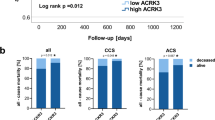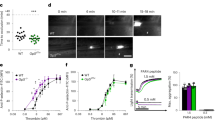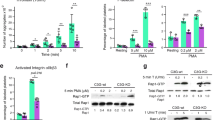Abstract
The growth arrest-specific gene 6 product (Gas6) is a secreted protein related to the anticoagulant protein S but its role in hemostasis is unknown. Here we show that inactivation of the Gas6 gene prevented venous and arterial thrombosis in mice, and protected against fatal collagen/epinephrine-induced thrombo embolism. Gas6−/− mice did not, however, suffer spontaneous bleeding and had normal bleeding after tail clipping. In addition, we found that Gas6 antibodies inhibited platelet aggregation in vitro and protected mice against fatal thrombo embolism without causing bleeding in vivo. Gas6 amplified platelet aggregation and secretion in response to known agonists. Platelet dysfunction in Gas6−/− mice resembled that of patients with platelet signaling transduction defects. Thus, Gas6 is a platelet-response amplifier that plays a significant role in thrombosis. These findings warrant further evaluation of the possible therapeutic use of Gas6 inhibition for prevention of thrombosis.
This is a preview of subscription content, access via your institution
Access options
Subscribe to this journal
Receive 12 print issues and online access
$209.00 per year
only $17.42 per issue
Buy this article
- Purchase on Springer Link
- Instant access to full article PDF
Prices may be subject to local taxes which are calculated during checkout





Similar content being viewed by others
References
Schneider, C., King, R.M. & Philipson, L. Genes specifically expressed at growth arrest of mammalian cells. Cell 54, 787–793 (1988).
Manfioletti, G., Brancolini, C., Avanzi, G. & Schneider, C. The protein encoded by a growth arrest-specific gene (gas6) is a new member of the vitamin K-dependent proteins related to protein S, a negative coregulator in the blood coagulation cascade. Mol. Cell. Biol. 13, 4976–4985 (1993).
Dahlback, B. Blood coagulation. Lancet 355, 1627–1632 (2000).
Dahlback, B. Protein S and C4b-binding protein: components involved in the regulation of the protein C anticoagulant system. Thromb. Haemost. 66, 49–61 (1991).
Borgel, D., Gandrille, S. & Aiach, M. Protein S deficiency. Thromb. Haemost. 78, 351–356 (1997).
Nakano, T. et al. Cell adhesion to phosphatidylserine mediated by a product of growth arrest-specific gene 6. J. Biol. Chem. 272, 29411–29414 (1997).
Varnum, B.C. et al. Axl receptor tyrosine kinase stimulated by the vitamin K-dependent protein encoded by growth-arrest-specific gene 6. Nature 373, 623–626 (1995).
Godowski, P.J. et al. Reevaluation of the roles of protein S and Gas6 as ligands for the receptor tyrosine kinase Rse/Tyro 3. Cell 82, 355–358 (1995).
Nagata, K. et al. Identification of the product of growth arrest-specific gene 6 as a common ligand for Axl, Sky, and Mer receptor tyrosine kinases. J. Biol. Chem. 271, 30022–30027 (1996).
Crosier, K.E. & Crosier, P.S. New insights into the control of cell growth; the role of the AxI family. Pathology 29, 131–135 (1997).
Chen, J., Carey, K. & Godowski, P.J. Identification of Gas6 as a ligand for Mer, a neural cell adhesion molecule related receptor tyrosine kinase implicated in cellular transformation. Oncogene 14, 2033–2039 (1997).
Goruppi, S., Ruaro, E. & Schneider, C. Gas6, the ligand of Axl tyrosine kinase receptor, has mitogenic and survival activities for serum starved NIH3T3 fibroblasts. Oncogene 12, 471–80 (1996).
Li, R. et al. Identification of Gas6 as a growth factor for human Schwann cells. J. Neurosci. 16, 2012–2019 (1996).
Nakano, T. et al. Vascular smooth muscle cell-derived, Gla-containing growth-potentiating factor for Ca(2+)-mobilizing growth factors. J. Biol. Chem. 270, 5702–5705 (1995).
Fridell, Y.W., Villa, J., Jr., Attar, E.C. & Liu, E.T. GAS6 induces Axl-mediated chemotaxis of vascular smooth muscle cells. J. Biol. Chem. 273, 7123–7126 (1998).
McCloskey, P. et al. GAS6 mediates adhesion of cells expressing the receptor tyrosine kinase Axl. J. Biol. Chem. 272, 23285–23291 (1997).
Lu, Q. et al. Tyro-3 family receptors are essential regulators of mammalian spermatogenesis. Nature 398, 723–728 (1999).
Rao, A.K. & Gabbeta, J. Congenital disorders of platelet signal transduction. Arterioscler. Thromb. Vasc. Biol. 20, 285–289 (2000).
Herbert, J.M., Bernat, A. & Maffrand, J.P. Importance of platelets in experimental venous thrombosis in the rat. Blood 80, 2281–2286 (1992).
Matsuno, H. et al. Effects of vapiprost, a novel thromboxane receptor antagonist, on thrombus formation and vascular patency after thrombolysis by tissue-type plasminogen activator. Br. J. Pharmacol. 106, 533–538 (1992).
Evenas, P., Garcia de Frutos, P., Nicolaes, G.A. & Dahlback, B. The second laminin G-type domain of protein S is indispensable for expression of full cofactor activity in activated protein C-catalysed inactivation of factor Va and factor VIIIa. Thromb. Haemost. 84, 271–277 (2000).
Offermanns, S., Toombs, C.F., Hu, Y.H. & Simon, M.I. Defective platelet activation in G α(q)-deficient mice. Nature 389, 183–186 (1997).
Bennett, J.S. Integrin structure and function in hemostasis and thrombosis. Ann. NY Acad. Sci. 614, 214–228 (1991).
Avanzi, G.C. et al. GAS6, the ligand of Axl and Rse receptors, is expressed in hematopoietic tissue but lacks mitogenic activity. Exp. Hematol. 25, 1219–1226 (1997).
Ishimoto, Y. & Nakano, T. Release of a product of growth arrest-specific gene 6 from rat platelets. FEBS Lett. 466, 197–199 (2000).
Marcus, A.J. Platelets and their disorders. in Disorders of Hemostasis (eds. Ratnoff, O.D. & Forbes, C.D.) 79–137 (W.B. Sauders, Philadelphia, Pennsylvania, 1996).
Mark, M.R., Chen, J., Hammonds, R.G., Sadick, M. & Godowsk, P.J. Characterization of Gas6, a member of the superfamily of G domain-containing proteins, as a ligand for Rse and Axl. J. Biol. Chem. 271, 9785–9789 (1996).
DiMinno, G. & Silver, M.J. Mouse antithrombotic assay: a simple method for the evaluation of antithrombotic agents in vivo. Potentiation of antithrombotic activity by ethyl alcohol. J. Pharmacol. Exp. Ther. 225, 57–60 (1983).
Neubauer, A. et al. Expression of axl, a transforming receptor tyrosine kinase, in normal and malignant hematopoiesis. Blood 84, 1931–1941 (1994).
O'Donnell, K., Harkes, I.C., Dougherty, L. & Wicks, I.P. Expression of receptor tyrosine kinase Axl and its ligand Gas6 in rheumatoid arthritis: evidence for a novel endothelial cell survival pathway. Am. J. Pathol. 154, 1171–1180 (1999).
Gabbeta, J. et al. Abnormal inside-out signal transduction-dependent activation of glycoprotein IIb-IIIa in a patient with impaired pleckstrin phosphorylation. Blood 87, 1368–76 (1996).
Fabre, J.E. et al. Decreased platelet aggregation, increased bleeding time and resistance to thrombo embolism in P2Y1-deficient mice. Nature Med. 5, 1199–1202 (1999).
Leon, C. et al. Defective platelet aggregation and increased resistance to thrombosis in purinergic P2Y(1) receptor-null mice. J. Clin. Invest. 104, 1731–1737 (1999).
Carmeliet, P. et al. Plasminogen activator inhibitor-1 gene-deficient mice. I. Generation by homologous recombination and characterization. J. Clin. Invest. 92, 2746–2755 (1993).
Vogel, G.M., Meuleman, D.G., Bourgondien, F.G. & Hobbelen, P.M. Comparison of two experimental thrombosis models in rats effects of four glycosaminoglycans. Thromb. Res. 54, 399–410 (1989).
Umemura, K., Nishiyama, H., Kikuchi, S., Kondo, K. & Nakashima, M. Inhibitory effect of a novel orally active GP IIb/IIIa inhibitor, SC-54684A on intimal thickening in the guinea pig femoral artery. Thromb. Haemost. 76, 799–806 (1996).
Kawasaki, T., Kaida, T., Arnout, J., Vermylen, J. & Hoylaerts, M.F. A new animal model of thrombophilia confirms that high plasma factor VIII levels are thrombogenic. Thromb. Haemost. 81, 306–3011 (1999).
Stassen, J.M., Vanlinthout, I., Lijnen, H.R. & Collen, D. A hamster pulmonary embolism model for the evaluation of the thrombolytic and pharmacokinetic properties of thrombolytic agents. Fibrinolysis 4, Supp., 15–21 (1990).
Dejana, E., Callioni, A., Quintana, A. & de Gaetano, G. Bleeding time in laboratory animals. II - A comparison of different assay conditions in rats. Thromb. Res. 15, 191–197 (1979).
Grinnell, B.W. et al. γ-carboxylated isoforms of recombinant human protein S with different biologic properties. Blood 76, 2546–2554 (1990).
Yan, S.B. Review of conformation-specific affinity purification methods for plasma vitamin K-dependent proteins. J. Mol. Recognit. 9, 211–218 (1996).
Savi, P. et al. Role of P2Y1 purinoceptor in ADP-induced platelet activation. FEBS Lett. 422, 291–295 (1998).
Graham, D.K., Dawson, T.L., Mullaney, D.L., Snodgrass, H.R. & Earp, H.S. Cloning and mRNA expression analysis of a novel human protooncogene, c-mer. Cell Growth. Differ. 5, 647–657 (1994).
Roth, J. Postembedding labeling on Lowicryl K4M tissue sections: detection and modification of cellular components. Methods Cell. Biol. 31, 513–551 (1989).
Lupu, F. et al. Localization and production of plasminogen activator inhibitor-1 in human healthy and atherosclerotic arteries. Arterioscler. Thromb. 13, 1090–1100 (1993).
Acknowledgements
We thank K. Bijnens, A. Bouché, I. Cartois, E. Demarsin, M. De Mol, K. Deroover, E. Gils, B. Hermans, S. Jansen, L. Kieckens, T. Vancoetsem, A. Vandenhoeck, I. Vanlinthout, M. Vanrusselt, P. Vanwesemael, I. Vreys and S. Wyns for technical assistance and J. Vermylen for critical reading of the manuscript. This work was supported by Sanofi Research and the Swedish Medical Research Council (Grants 07143, 12561 and 13000) and a Senior Investigators Award from the Swedish Foundation for Strategic Research. A. Angelillo-Scherrer is a recipient of awards from the Swiss National Foundation for Scientific Research and the Fondation Suisse pour les Bourses en Médecine et Biologie.
Author information
Authors and Affiliations
Corresponding author
Rights and permissions
About this article
Cite this article
Angelillo-Scherrer, A., de Frutos, P., Aparicio, C. et al. Deficiency or inhibition of Gas6 causes platelet dysfunction and protects mice against thrombosis. Nat Med 7, 215–221 (2001). https://doi.org/10.1038/84667
Received:
Accepted:
Issue Date:
DOI: https://doi.org/10.1038/84667
This article is cited by
-
Regulation of brain endothelial cell physiology by the TAM receptor tyrosine kinase Mer
Communications Biology (2023)
-
AXL receptor tyrosine kinase as a promising anti-cancer approach: functions, molecular mechanisms and clinical applications
Molecular Cancer (2019)
-
Tyro3, Axl, and Mertk receptors differentially participate in platelet activation and thrombus formation
Cell Communication and Signaling (2018)
-
Efferocytosis in the tumor microenvironment
Seminars in Immunopathology (2018)
-
A critical role of Gas6/Axl signal in allergic airway responses during RSV vaccine‐enhanced disease
Immunology & Cell Biology (2017)



